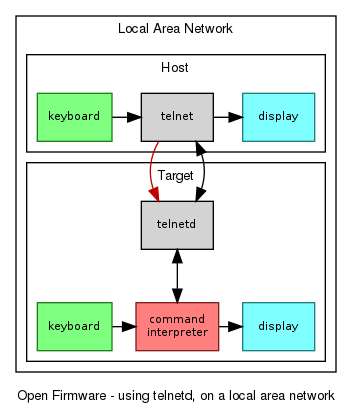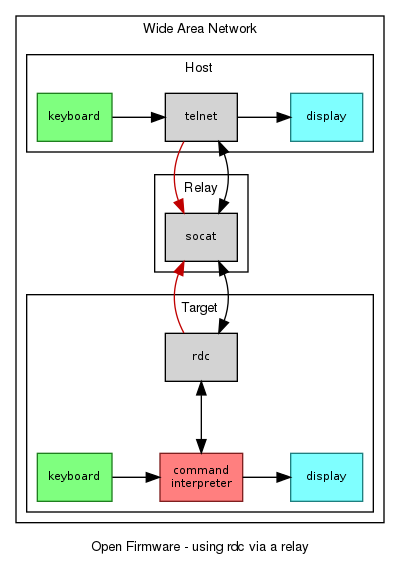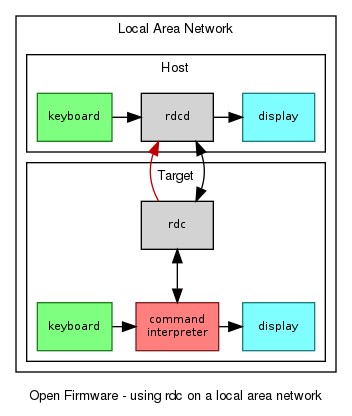Firmware/Remote
Firmware Remote Diagnosis
Using telnetd
On the target system:
- start the telnet server:
ok telnetd
- note the IP address shown,
- wait for connection to arrive.
On the host system:
- start the telnet client and connect to the IP address,
ok telnet IP
Once connected, the host keyboard and display will be using the command interpreter of the target.
To disconnect, type exit-telnet in the target command interpreter, or use ^] to exit the telnet client.
This method is ineffective if the target system is behind a NAT router with respect to the host, since the IP address is not routable.
Using rdc via a relay
Scenario: need to connect to a user laptop that is behind a NAT router. You are at the host.
On a relay server that is accessible to the user over the internet:
- set up a TCP relay that listens on ports 8024 and 8023:
% socat \ TCP-LISTEN:8024,fork,reuseaddr,nodelay,bind=127.0.0.1 \ TCP-LISTEN:8023,reuseaddr,nodelay
On the host system:
- start a telnet client and connect to port 8024 on the relay server:
ok telnet IP 8024
- (or, on a Linux client, type:
% telnet -- 127.0.0.1 -8024
- the odd arguments are to force automatic initiation of TELNET options which would otherwise be omitted due to the non-standard port number).
On the target system, ask the user to start rdc:
ok rdc IP
- where IP is the IP address of the relay server.
Once connected, the host keyboard and display will be using the command interpreter of the target.
To disconnect, type exit-rdc in the target command interpreter, or use ^] to exit the telnet program on the host.
The port number can be changed by mutual agreement. The default is 8023. For instance, to use port 9023 you must (a) change the socat command from 8023 to 9023, and (b) add 9023 to the end of the rdc command:
ok rdc IP 9023
Using rdc on a local area network
On the host system:
- start
rdcdto listen for connections, and note the IP address shown,
ok rdcd
On the target system:
- type
rdc IP,
ok rdc IP
Once connected, the host keyboard and display will be using the command interpreter of the target.
To disconnect, type exit-rdc in the target command interpreter, or use ^] to exit the rdcd program on the host.
This method is ineffective if the host system is behind a NAT router with respect to the target, since the IP address is not routable.
Combining with serial terminal
Use of rdc, rdcd, telnet and telnetd are ineffective if the problem being diagnosed is networking. In that case, the target firmware system must be accessed via serial.
Therefore, use another system as a relay, and start the serial program.
Internals
- telnet - a plain telnet client,
- telnetd - a telnet server that binds the console to the accepted connection,
- rdc - a telnetd that makes rather than accepting a connection.
- rdcd - a telnet that accepts rather than making a connection.


